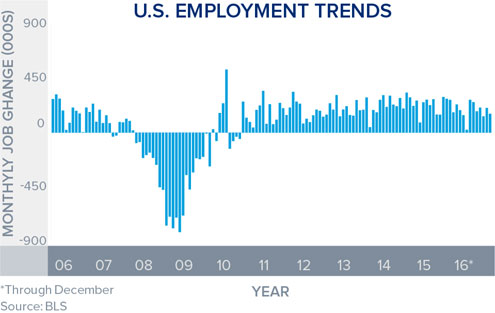Investors that act before the spring buying season will be rewarded with lower capital costs and lower median home prices
The December jobs report from the Bureau of Labor Statistics was emblematic of U.S. economic situation in 2016. Employers added 156,000 jobs last month, below expectations but good enough to keep the economy moving forward. The breakout year for the current economic cycle has remained elusive, and may fail to arrive before the next recession. Nonetheless, the economy has added jobs for 75 consecutive months, the longest stretch in the post-war era. Unemployment remained below the full-employment threshold of 5 percent, ticking up 10 basis points to 4.7 percent.
The long-elusive wage growth component of the establishment survey arrived in December. Workers received a 2.9 percent raise compared to the same month last year, the quickest pace since 2009. A wildcard in wage growth last month was a plan to lift the limit of exempt employees’ salaries. Employers may have acted prior to a ruling by a Federal court in late November, just a week before the change was scheduled to be implemented. Another month of solid wage gains will paint a clearer picture of whether or not the tight job market is finally supporting competition among employers.

For real estate investors, December’s job report does little to derail the Fed’s plan to raise the federal funds rate three times in 2017. Interest rates have finally ceased their upward march after a flurry of activity leading up to the Fed’s December meeting. Overall, banks appear to have priced in a portion of the next hike, and will move ahead of the Fed as long as the economy remains on the current trajectory. As a result, investors that act before the spring buying season will be rewarded with lower capital costs and lower median home prices.